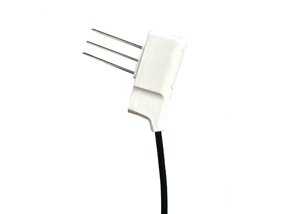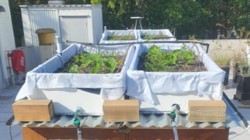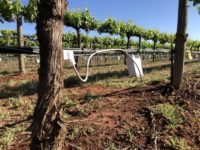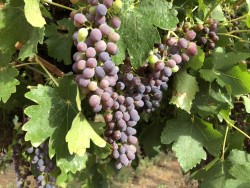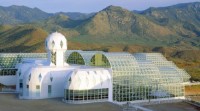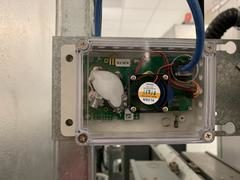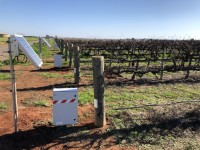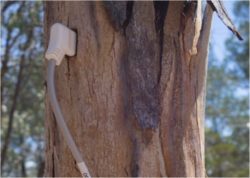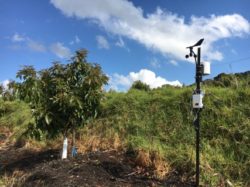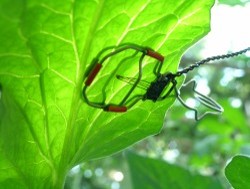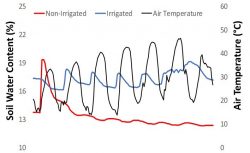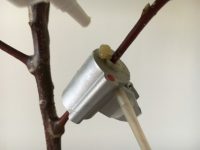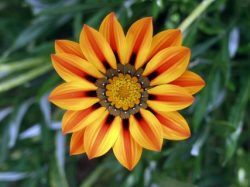plants
An endangered frog and soil water potential
Soil water potential, an endangered frog and climate change are three topics rarely discussed together. Yet, recent research from the University of Western Australia found that the successful breeding of an endangered frog is intricately linked with soil water potential which, in turn, may be altered by climate change dynamics. Understanding the interplay of these…
Read MoreStem water content: a new sensor for plant water relations
A new stem water content sensor has been released by Implexx Sense. The new sensor will enhance the understanding of plant water relations and will also assist plant physiologists, ecohydrologists, modellers and more. what is stem water content? Stem water content, also known as sapwood water content or moisture, gravimetric or volumetric water content,…
Read MoreMonitoring of subtropical green roof water balance in Brisbane
Author: Sylvie Kunz PhD candidate, Green Infrastructure Research Labs (GIRLS), Cities Research Institute, Griffith University, Queensland, Australia Green roofs are a nature-based approach to help cities overcome the negative effects of urbanisation. By greening the cities, stormwater can be retained, the urban environment cooled, and habitats can be created. Monitoring of green roof water…
Read MoreReducing water inputs with on demand irrigation scheduling
New research has shown up to 40% reduction in irrigation can be achieved with soils or plant based decision making. Water resources are becoming increasingly expensive and scarce. To reduce costs and save on water, it is possible to alter irrigation scheduling (i.e. timing and dosing). Yet, when altering or decreasing irrigation it is critical…
Read MoreIrrigation with sap flow sensors: a video explainer
Irrigation managers face two questions: when and how much to irrigate. A new video, available on YouTube and with a weblink below, explains how sap flow sensors can be used for irrigation scheduling and dosing. Sap flow sensors measure crop water use or transpiration. With a sap flow sensor, it is possible to determine how…
Read MoreSap flow, evapotranspiration and irrigation management
Irrigating scheduling and amount can be accurately determined by combining sap flow (crop water use) sensors and evapotranspiration (ETo) data. This article outlines how growers, researchers or physiologists can use the Implexx Sap Flow Sensor, alongside the ATMOS 41 weather station, or the Implexx Evapotranspiration (ETo) station. Although this article has a focus on grapevines,…
Read MoreAquaponics supported by internet enabled water quality sensors
EcoSystem Farms is utilising modern techniques in aquaponics to create a natural farming system that is -cide free – that is no herbicides or pesticides! Based on the Fleurieu Peninsula, South Australia, EcoSystem Farms deploys ecological principles to create a natural loop between fish and plants where the fish provide the nutrients and the plants…
Read MoreBiosphere 2 and sap flow sensors: how do tropical trees behave under drought?
monitoring water uptake and transport of a model rainforest ecosystem Author: Kathrin Kühnhammer PhD Student at TU Braunschweig, Environmental Geochemistry, Germany Pictures of a) tropical rainforest glass house in the Biosphere 2 complex, b) inside the tropical rainforest model ecosystem and c) water content and sap flow sensor as well as borehole to…
Read MoreCO2 sensors in a greenhouse laboratory
Edaphic Scientific supplies a large range of carbon dioxide (CO2) detectors that are suitable for greenhouses and glasshouses. In this article, our supplier of CO2 detectors, CO2Meter, interviewed researchers from NC State University on how they deploy CO2 sensors in their greenhouses. This article originally appeared on the CO2Meter.com website. One intriguing CO2Meter collaboration…
Read MoreBushfires and assessing the risk of erosion
After a long season of bushfires in Australia, many of which are still burning, it is important to look forward to recovery and regeneration. There is much to do, measure and assess. Among these is the risk of soil erosion particularly where heavy rainfall, or high winds, impact bare ground. This article was first published…
Read MoreImplexx Sap Flow Sensor: a new sap flow sensor for the digital age
A new sap flow sensor has been released by Implexx Sense! The Implexx Sap Flow Sensor is a low cost, easy to use and maintain sap flow sensor designed by scientists and engineers from the Australian company, Implexx. Implexx Sap Flow Sensor was designed with the scientists and grower in mind – it has all…
Read MoreSap flow data show grapevines can tolerate extreme heatwave events
Monitoring sap flow on grapevines during extreme heatwave events has demonstrated that vines can tolerate extreme conditions when soil moisture levels were high. These results were found via the grapevine and heatwave monitoring project in the Riverina region of New South Wales (NSW), Australia. Heatwaves are “three or more days of high maximum and minimum…
Read MoreA new introductory video on sap flow
What is sap flow? Is it water or sugars in the plant? What is the difference between sap flow and transpiration? Why measure sap flow? If you are new to the world of sap flow science, then the team at Implexx and Edaphic Scientific have released a new video for you. Sap Flow: An Introduction…
Read MoreNew tensiometer-style sensor for avocado growers
A new, tensiometer-style sensor is improving irrigation management and saving time and costs for avocado growers. Irrigation monitoring and scheduling often relies on tensiometers – sensors that can measure soil water potential. Tensiometers are a favourite among avocado growers but they come with a huge problem: they are extremely tedious and odious to maintain. A…
Read MoreLeaf temperature sensors and water wise research
Plant physiologists and irrigation scientists need accurate and reliable leaf and canopy temperature sensors for scientific research. Recently, the LT-1T Leaf Temperature Sensor from Edaphic Scientific was deployed by researchers at the CSIRO for a project on irrigation management of tomato crops. The LT-1T is a small, temperature sensor that firmly clips onto a leaf.…
Read MoreGrapevines, sap flow and heatwaves
Heatwaves can have a significant impact on grapevines, scorching leaves and decreasing growth and yield. Grape growers deploy various strategies to protect their vines during extreme heat events which can include spraying canopies with “sunscreen”. Although these strategies have merit, they often involve investment in additional infrastructure or are laborious to employ. Another strategy involves…
Read MoreDetection of tree disease with sap flow sensors
Sap flow sensors can be used to study the hydraulic function of healthy versus diseased trees. Sap flow sensors can detect a decrease in hydraulic function associated with disease prior to the onset of outward, physical symptoms. Sap flow sensors, therefore, provide a tool for researchers to better understand the physiology of disease in trees.…
Read MoreDendrometers: multi-purpose sensors
Dendrometers are a multi-purpose sensor for measuring plant growth and water use. They are a precision sensor to measure small expansion and contractions in plant tissues over a daily cycle. They can also measure growth over several days, weeks and months. Therefore, dendrometers can be used for irrigation and fertigation management, as well as providing…
Read MoreMeasuring transpiration of small plants
Continuous measurements of the water use, or transpiration, of small or herbaceous plants can be difficult. A small weighing lysimeter, also known as a balance or scale, can be used however these often require a researcher to manually read the LCD screen or to have the instrument connected to a PC or laptop. Data collection…
Read MoreFlowers and transpiration
Surprisingly little research has been dedicated to flower water relations. This is despite the vast amount of research on water relations at the whole-plant level, stomatal conductance at the leaf level, and even the water relations of fruits. Flowers have been largely neglected probably due to the difficulty of accurately measuring transpiration rates with a…
Read More

